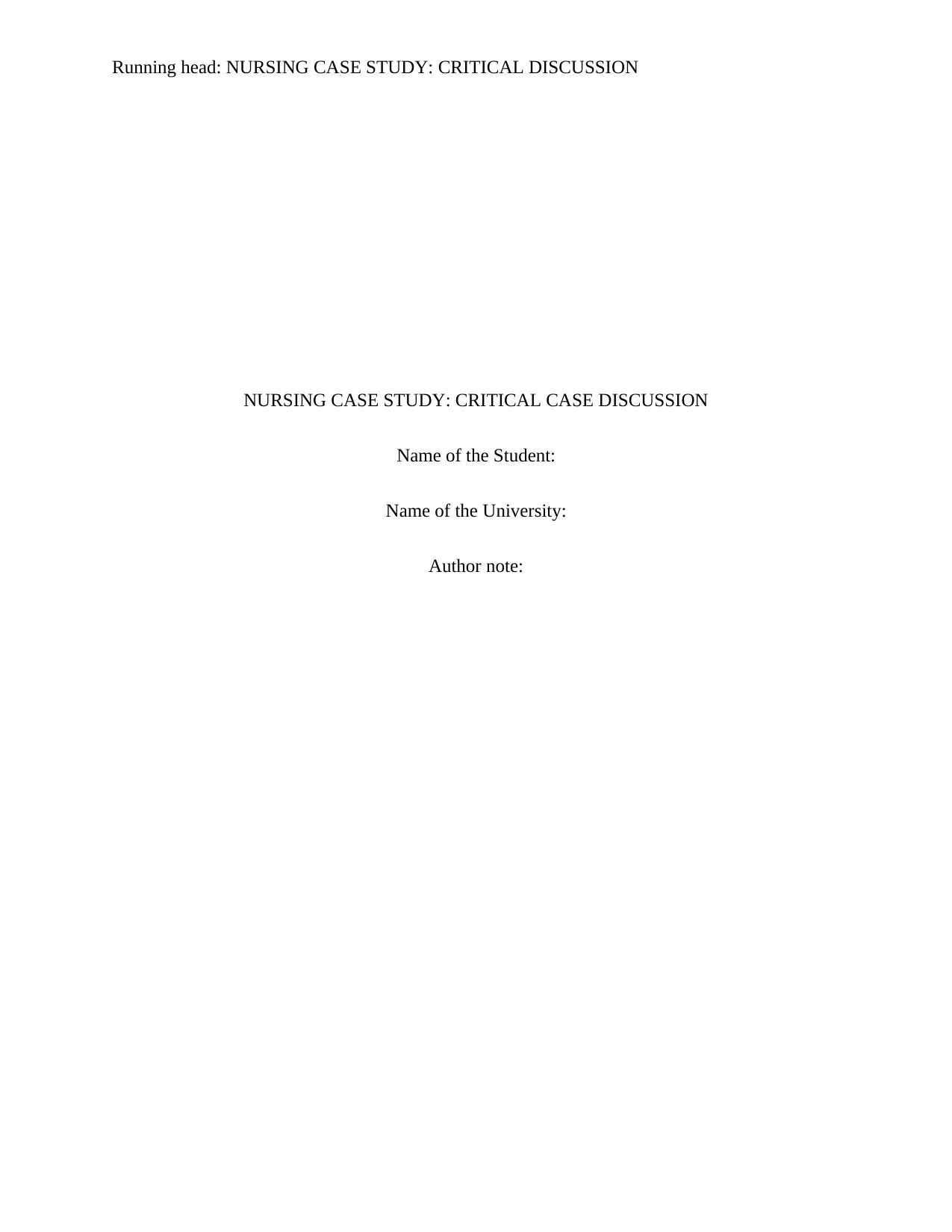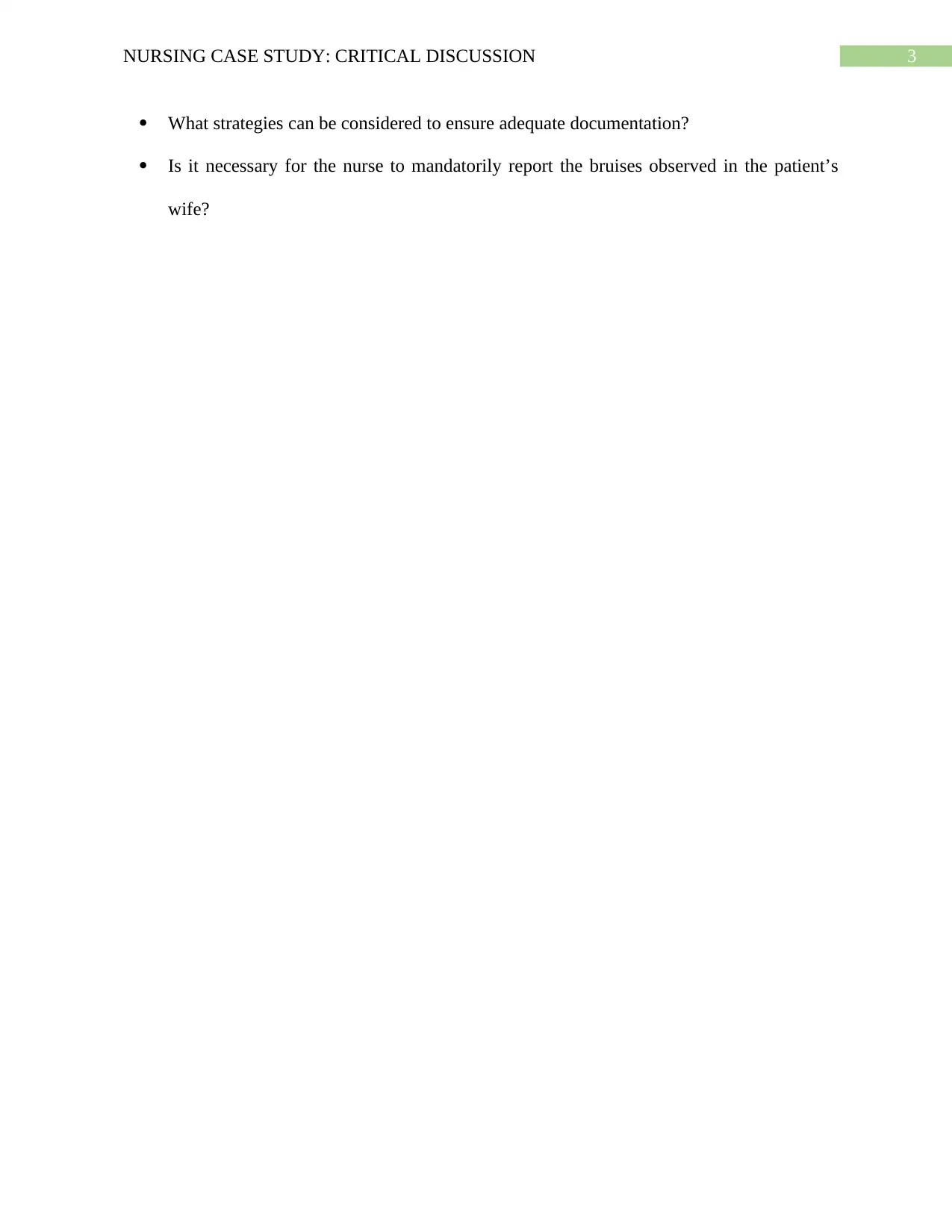NURSING CASE STUDY: CRITICAL DISCUSSION - [University Name]
VerifiedAdded on 2022/09/23
|5
|1091
|25
Discussion Board Post
AI Summary
This assignment presents a critical discussion of a nursing case study, focusing on two key challenging situations. The first involves a new RN's lack of experience in leading a team during an understaffed shift, compounded by a colleague's burnout. The second highlights a conflict and ethical dilemma between a patient's son and a nurse. The student analyzes these situations, expressing their feelings and proposing actions as a registered nurse, referencing personal experiences from clinical placements. The discussion is supported by peer-reviewed journal articles to provide evidence-based solutions for managing stress, conflict, and ensuring quality patient care in challenging healthcare environments. The assignment also explores the ethical considerations and the importance of effective communication and teamwork in nursing practice.

Running head: NURSING CASE STUDY: CRITICAL DISCUSSION
NURSING CASE STUDY: CRITICAL CASE DISCUSSION
Name of the Student:
Name of the University:
Author note:
NURSING CASE STUDY: CRITICAL CASE DISCUSSION
Name of the Student:
Name of the University:
Author note:
Paraphrase This Document
Need a fresh take? Get an instant paraphrase of this document with our AI Paraphraser

1NURSING CASE STUDY: CRITICAL DISCUSSION
Situation 1
One of the first challenging situations is the new RN’s lack of experience in leading a
team in an understaffed situation and during Sarah’s feelings of burnout and stress. According to
Fong (2016), lack of mitigation of burnout and stress across nurses can contribute to an inability
to deliver effective interventions, inability to cope with challenging situations and resultant
increased risk of medical errors and fatal patient outcomes. These effects are more pronounced in
new RNs who lack experience and adequate support transitioning. The severity of these risks are
further aggravated by environmental challenges like understaffing and high patient influx – as
observed in the case study (Woodhead, Northrop & Edelstein, 2016). Additionally, compassion
fatigue hinders the ability for new nurses to transition effectively – as observed and the inability
of the novice RN to lead the team in Sarah’s absence (Woodhead, Northrop & Edelstein, 2016). I
would definitely feel concerned for my peer Sarah which in turn, would affect my concentration
and functioning as a new RN. Plus, being entrusted with the job of a team leader as a new RN, in
the absence of my experienced peer and an understaffed situation would cause additional
feelings of stress and fatigue in me due to the increased workload. Indeed, it has been evidenced
by Adam (2019), that nursing burnout can contribute to attrition, increased work load and risk of
nursing errors. It is the duty of healthcare organizations to make arrangements for addressing
burnout in nurses as well as maintain sufficient nurse-patient ratios to manage high patient influx
(Adams, Hollingsworth & Osman, 2019). I would thus report Sarah’s condition to my
supervisors and request for another EN or AIN to assist me in team leading. A similar experience
for burnout was encountered by me during my clinical placement as an AIN where a new RN
found it difficult to assist me in an emergency patient situation. The supervisor advised me and
my friend to consult the organization’s referral counseling services. Implementing counseling
Situation 1
One of the first challenging situations is the new RN’s lack of experience in leading a
team in an understaffed situation and during Sarah’s feelings of burnout and stress. According to
Fong (2016), lack of mitigation of burnout and stress across nurses can contribute to an inability
to deliver effective interventions, inability to cope with challenging situations and resultant
increased risk of medical errors and fatal patient outcomes. These effects are more pronounced in
new RNs who lack experience and adequate support transitioning. The severity of these risks are
further aggravated by environmental challenges like understaffing and high patient influx – as
observed in the case study (Woodhead, Northrop & Edelstein, 2016). Additionally, compassion
fatigue hinders the ability for new nurses to transition effectively – as observed and the inability
of the novice RN to lead the team in Sarah’s absence (Woodhead, Northrop & Edelstein, 2016). I
would definitely feel concerned for my peer Sarah which in turn, would affect my concentration
and functioning as a new RN. Plus, being entrusted with the job of a team leader as a new RN, in
the absence of my experienced peer and an understaffed situation would cause additional
feelings of stress and fatigue in me due to the increased workload. Indeed, it has been evidenced
by Adam (2019), that nursing burnout can contribute to attrition, increased work load and risk of
nursing errors. It is the duty of healthcare organizations to make arrangements for addressing
burnout in nurses as well as maintain sufficient nurse-patient ratios to manage high patient influx
(Adams, Hollingsworth & Osman, 2019). I would thus report Sarah’s condition to my
supervisors and request for another EN or AIN to assist me in team leading. A similar experience
for burnout was encountered by me during my clinical placement as an AIN where a new RN
found it difficult to assist me in an emergency patient situation. The supervisor advised me and
my friend to consult the organization’s referral counseling services. Implementing counseling

2NURSING CASE STUDY: CRITICAL DISCUSSION
referrals via employee assistant programs is a beneficial way by which organizations can address
nursing burnout (Adams, Hollingsworth & Osman, 2019).
Was it right to appoint a novice RN as a team leader?
Was it right to allow Sarah to work considering her condition? What alternative strategies
could have been used considering the understaffed conditions?
Situation 2
The second challenging situation is the conflict and ethical dilemma which occurred
between the patient’s son and the nurse during the patient’s life threatening situation. Conflicts
occur due to client centered as well as organizational factors. Conflicts with families arise in the
face of patient adversities while conflicts can also arise due to inappropriate organizational
practices – in this, lack of cooperation from the AIN and documentation by the doctor. Either
way, conflicts, if not managed can contribute to errors, loss of nurse-patient trust, poor team
management and adverse health outcomes (Kwon, Ahn, Kwak & Yun, 2019). I would have
definitely have felt overwhelmed and anxious in this situation but to manage the same, I would
have tried to empathetically talk to the patient’s son regarding the best efforts being given by the
staff. Empathetic interpersonal communication rebuilds trust and confidence across patient
families (Gerace, Oster, O'kane, Hayman & Muir‐Cochrane, 2018). I would also calmly
communicate my feelings to the AIN later. Nursing interpersonal communication fosters team
building and improved team work (Kuo, Huang, Sun & Lin, 2019). During my clinical
placement as an AIN, I once had to talk an emotional and excited family member of a patient in
critical condition. After empathizing and assuring her our efforts, she finally calmed down, thus
demonstrating the importance of empathy.
referrals via employee assistant programs is a beneficial way by which organizations can address
nursing burnout (Adams, Hollingsworth & Osman, 2019).
Was it right to appoint a novice RN as a team leader?
Was it right to allow Sarah to work considering her condition? What alternative strategies
could have been used considering the understaffed conditions?
Situation 2
The second challenging situation is the conflict and ethical dilemma which occurred
between the patient’s son and the nurse during the patient’s life threatening situation. Conflicts
occur due to client centered as well as organizational factors. Conflicts with families arise in the
face of patient adversities while conflicts can also arise due to inappropriate organizational
practices – in this, lack of cooperation from the AIN and documentation by the doctor. Either
way, conflicts, if not managed can contribute to errors, loss of nurse-patient trust, poor team
management and adverse health outcomes (Kwon, Ahn, Kwak & Yun, 2019). I would have
definitely have felt overwhelmed and anxious in this situation but to manage the same, I would
have tried to empathetically talk to the patient’s son regarding the best efforts being given by the
staff. Empathetic interpersonal communication rebuilds trust and confidence across patient
families (Gerace, Oster, O'kane, Hayman & Muir‐Cochrane, 2018). I would also calmly
communicate my feelings to the AIN later. Nursing interpersonal communication fosters team
building and improved team work (Kuo, Huang, Sun & Lin, 2019). During my clinical
placement as an AIN, I once had to talk an emotional and excited family member of a patient in
critical condition. After empathizing and assuring her our efforts, she finally calmed down, thus
demonstrating the importance of empathy.
⊘ This is a preview!⊘
Do you want full access?
Subscribe today to unlock all pages.

Trusted by 1+ million students worldwide

3NURSING CASE STUDY: CRITICAL DISCUSSION
What strategies can be considered to ensure adequate documentation?
Is it necessary for the nurse to mandatorily report the bruises observed in the patient’s
wife?
What strategies can be considered to ensure adequate documentation?
Is it necessary for the nurse to mandatorily report the bruises observed in the patient’s
wife?
Paraphrase This Document
Need a fresh take? Get an instant paraphrase of this document with our AI Paraphraser

4NURSING CASE STUDY: CRITICAL DISCUSSION
References
Adams, A., Hollingsworth, A., & Osman, A. (2019). The Implementation of a Cultural Change
Toolkit to Reduce Nursing Burnout and Mitigate Nurse Turnover in the Emergency
Department. Journal of Emergency Nursing, 45(4), 452-456. doi:
https://doi.org/10.1016/j.jen.2019.03.004.
Fong, C. M. (2016). Role overload, social support, and burnout among nursing
educators. Journal of Nursing Education, 29(3), 102-108. doi:
https://doi.org/10.3928/01484834-19900301-07.
Gerace, A., Oster, C., O'kane, D., Hayman, C. L., & Muir‐Cochrane, E. (2018). Empathic
processes during nurse–consumer conflict situations in psychiatric inpatient units: A
qualitative study. International Journal of Mental Health Nursing, 27(1), 92-105. doi:
https://doi.org/10.1111/inm.12298.
Kuo, F. H., Huang, H. M., Sun, F. K., & Lin, W. J. (2019). Interpersonal Communication
Competence and Conflict Handling Styles of Nurses in Intensive Care Units. Hu Li Za
Zhi, 66(2), 67-76. doi: 10.6224/JN.201904_66(2).09.
Kwon, S. B., Ahn, H. Y., Kwak, M. H., & Yun, S. H. (2019). Conflicts Experienced by the
Nurses in Hospital Nursing Organizations. Journal of Korean Academy of Nursing
Administration, 25(5), 499-509. doi: https://doi.org/10.11111/jkana.2019.25.5.499.
Woodhead, E. L., Northrop, L., & Edelstein, B. (2016). Stress, social support, and burnout
among long-term care nursing staff. Journal of applied gerontology, 35(1), 84-105. doi:
https://doi.org/10.1177%2F0733464814542465.
References
Adams, A., Hollingsworth, A., & Osman, A. (2019). The Implementation of a Cultural Change
Toolkit to Reduce Nursing Burnout and Mitigate Nurse Turnover in the Emergency
Department. Journal of Emergency Nursing, 45(4), 452-456. doi:
https://doi.org/10.1016/j.jen.2019.03.004.
Fong, C. M. (2016). Role overload, social support, and burnout among nursing
educators. Journal of Nursing Education, 29(3), 102-108. doi:
https://doi.org/10.3928/01484834-19900301-07.
Gerace, A., Oster, C., O'kane, D., Hayman, C. L., & Muir‐Cochrane, E. (2018). Empathic
processes during nurse–consumer conflict situations in psychiatric inpatient units: A
qualitative study. International Journal of Mental Health Nursing, 27(1), 92-105. doi:
https://doi.org/10.1111/inm.12298.
Kuo, F. H., Huang, H. M., Sun, F. K., & Lin, W. J. (2019). Interpersonal Communication
Competence and Conflict Handling Styles of Nurses in Intensive Care Units. Hu Li Za
Zhi, 66(2), 67-76. doi: 10.6224/JN.201904_66(2).09.
Kwon, S. B., Ahn, H. Y., Kwak, M. H., & Yun, S. H. (2019). Conflicts Experienced by the
Nurses in Hospital Nursing Organizations. Journal of Korean Academy of Nursing
Administration, 25(5), 499-509. doi: https://doi.org/10.11111/jkana.2019.25.5.499.
Woodhead, E. L., Northrop, L., & Edelstein, B. (2016). Stress, social support, and burnout
among long-term care nursing staff. Journal of applied gerontology, 35(1), 84-105. doi:
https://doi.org/10.1177%2F0733464814542465.
1 out of 5
Your All-in-One AI-Powered Toolkit for Academic Success.
+13062052269
info@desklib.com
Available 24*7 on WhatsApp / Email
![[object Object]](/_next/static/media/star-bottom.7253800d.svg)
Unlock your academic potential
Copyright © 2020–2025 A2Z Services. All Rights Reserved. Developed and managed by ZUCOL.
